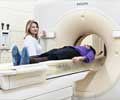Imaging can now be used as a tool for identifying severe cases of H1N1 and may play an essential role in understanding the pathogenesis of the virus, possibly leading to earlier diagnoses of severe cases in the future, researchers at the National Institutes of Health (NIH) have found.
The researchers said that imaging revealed a severe case of H1N1 after a patient had tested negative using a nasal swab rapid antigen test.Radiography (standard X-ray) showed peripheral lung opacities, and computed tomography (CT) revealed peripheral ground-glass opacities.
Both findings raised suspicion of H1N1 and reports revealed that the patient later died from a severe case of H1N1.
"The role of radiologic imaging in epidemic detection and response is evolving, with imaging being used as a tool for identifying severe cases," said Daniel J. Mollura, M.D., lead author of the study.
"At the Center for Infectious Disease Imaging (CIDI) at the NIH, the study of influenza is a priority with a focus on achieving early diagnosis and understanding its pathogenesis.
"Early CT may help clinicians recognize cases of severe influenza and monitor response to treatment. More cases will certainly need to be analyzed and compared in the future, but this is a promising early result," he added.
Advertisement
Source-ANI
LIN









